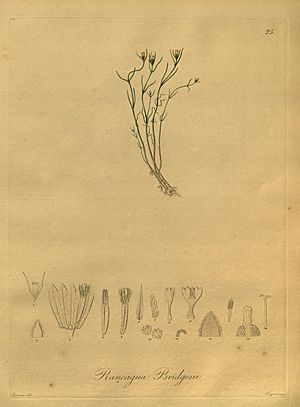Lasthenia kunthii facts for kids
Quick facts for kids Lasthenia kunthii |
|
|---|---|
 |
|
| Scientific classification | |
| Genus: |
Lasthenia
|
| Species: |
kunthii
|
Lasthenia kunthii is a special type of plant, often called ranca. It is a small herb that grows only in central Chile. When a plant or animal is found only in one specific area, we say it is endemic to that place.
This plant was first discovered and collected in a place called Rancagua. It loves to grow in wet areas, like near lagoons or in grassy fields that have a lot of salt. These are called inundated environments because they are often covered in water.
You can mostly find Lasthenia kunthii between the cities of Coquimbo and Valdivia in Chile. But it has also been seen much further south in Ultima Esperanza, which is in the Magallanes Region. It even grows in some parts of Argentina, in the provinces of Chubut and Río Negro.
What is Lasthenia kunthii?
Lasthenia kunthii is a scientific name given to this plant by the botanists Hook. and Arn. It helps scientists around the world know exactly which plant they are talking about. Sometimes, it was also known by another scientific name, L. obtusifolia, but Lasthenia kunthii is the name used today.
This plant is part of a larger group of plants called Lasthenia. These plants are known for their small, often yellow, daisy-like flowers. They are usually annuals, meaning they complete their whole life cycle, from seed to flower to seed, within one year.
Where Does Ranca Grow?
Ranca is quite adaptable, but it prefers specific conditions. It thrives in places where the soil is often wet or even flooded. This is why you find it near bodies of water or in low-lying areas. The plant can also handle salty soil, which is not common for many plants. This ability allows it to grow in unique habitats that other plants might avoid.
Its main home is in central Chile, a region with a Mediterranean climate. This means it has mild, wet winters and hot, dry summers. However, the plant's ability to grow in very different places, from Coquimbo in the north to Magallanes in the far south, shows how tough it is. Finding it in Argentina also highlights its wider natural range across South America.
Life Cycle of the Ranca Plant
Like many herbs, Lasthenia kunthii likely grows from seeds each year. It sprouts when conditions are right, usually after rains or when its environment becomes wet. It then grows quickly, produces its flowers, and makes new seeds. These seeds will wait in the soil until the next suitable season to sprout again. This cycle helps the plant survive in places where water levels change throughout the year.
The flowers of Lasthenia kunthii are important for its reproduction. They attract insects, like bees, which help carry pollen from one flower to another. This process, called pollination, is how plants make new seeds. The seeds then fall to the ground, ready to start the next generation of ranca plants.
See also
 In Spanish: Ranca para niños
In Spanish: Ranca para niños

